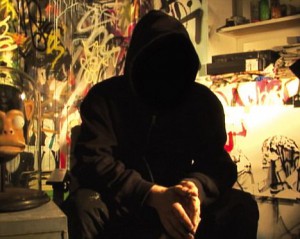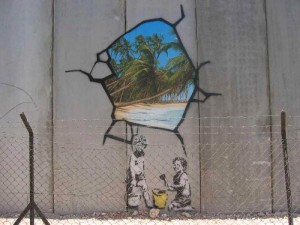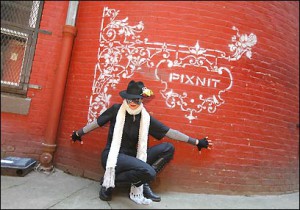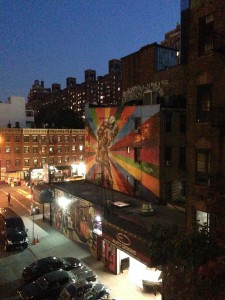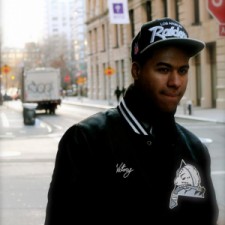Check out the PowerPoint Presentation for anonymousartnyc.com
GRAFFITI: Anonymous Artists
Graffiti artists constantly have the looming threat of facing consequences for displaying their graffiti. Many choose to protect their identities and reputation by remaining anonymous.
With the commercialization of graffiti (and hip hop in general), in most cases, even with legally painted “graffiti” art, graffiti artists tend to choose anonymity. This may be attributed to various reasons or a combination of reasons. Graffiti still remains the one of four hip hop elements that is not considered “performance art” despite the image of the “singing and dancing star” that sells hip hop culture to the mainstream. Being a graphic form of art, it might also be said that many graffiti artists still fall in the category of the introverted archetypal artist.
Banksy is one of the world’s most notorious and popular street artists who continues to remain faceless in today’s society. He is known for his political, anti-war stencil art mainly in England, but his work may be seen anywhere from Los Angeles to Palestine. In the UK, Banksy is the most recognizable icon for this cultural artistic movement and keeps his identity a secret to avoid arrest. Much of Banksy’s artwork may be seen around the streets of London and surrounding suburbs, although he has painted pictures throughout the world, including the Middle East, where he has painted on Israel’s controversial West Bank barrier with satirical images of life on the other side. One depicted a hole in the wall with an idyllic beach, while another shows a mountain landscape on the other side. A number of exhibitions also have taken place since 2000, and recent works of art have fetched vast sums of money. Banksy’s art is a prime example of the classic controversy: vandalism vs. art. Art supporters endorse his work distributed in urban areas as pieces of art and some councils, such as Bristol and Islington, have officially protected them, while officials fof other areas have deemed his work to be vandalism and have removed it.
Pixnit is another artist who chooses to keep her identity from the general public. Her work focuses on beauty and design aspects of graffiti as opposed to Banksy’s anti-government shock value. Her paintings are often of flower designs above shops and stores in her local urban area of Cambridge, Massachusetts. Some store owners endorse her work and encourage others to do similar work as well.
GRAFFITI: Contemporary Graffiti
Graffiti writing is often seen as having become intertwined with hip hop culture and the myriad international styles derived from New York City Subway graffiti. However, there are many other instances of notable graffiti this century. Graffiti have long appeared on building walls, in latrines, railroad boxcars, subways, and bridges.
During World War II and for decades after, the phrase “Kilroy was here” with an accompanying illustration was widespread throughout the world, due to its use by American troops and ultimately, filtering into American popular culture. A popular graffito of the 1970s was the legend “Dick Nixon Before He Dicks You”, reflecting the hostility of the youth culture to that U.S. president.
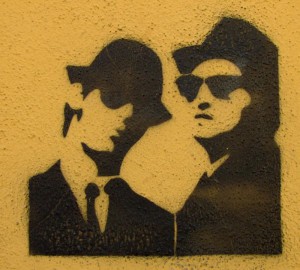 Rock and roll graffiti is a significant sub genre. A famous graffito of the twentieth century was the inscription in the London tube reading “Clapton is God” in a link to the guitarist Eric Clapton. The phrase was spray-painted by an admirer on a wall in an Islington Underground station in the autumn of 1967. The graffiti was captured in a photograph, in which a dog is urinating on the wall. Graffiti also became associated with the anti-establishment punk rock movement beginning in the 1970s. Rock bands widely stenciled their names and logos, while many punk night clubs, squats, and hangouts are famous for their graffiti. In the late 1980s the upside down Martini glass that was the tag for punk band Missing Foundation was the most ubiquitous graffito in lower Manhattan, and was copied by hard core punk fans throughout the US and West Germany.
Rock and roll graffiti is a significant sub genre. A famous graffito of the twentieth century was the inscription in the London tube reading “Clapton is God” in a link to the guitarist Eric Clapton. The phrase was spray-painted by an admirer on a wall in an Islington Underground station in the autumn of 1967. The graffiti was captured in a photograph, in which a dog is urinating on the wall. Graffiti also became associated with the anti-establishment punk rock movement beginning in the 1970s. Rock bands widely stenciled their names and logos, while many punk night clubs, squats, and hangouts are famous for their graffiti. In the late 1980s the upside down Martini glass that was the tag for punk band Missing Foundation was the most ubiquitous graffito in lower Manhattan, and was copied by hard core punk fans throughout the US and West Germany.
In 1979, graffiti artist Lee Quinones and Fab 5 Freddy were given a gallery opening in Rome by art dealer Claudio Bruni. For many outside of New York, it was their first encounter with their art form. Fab 5 Freddy’s friendship with Debbie Harry influenced Blondie’s single “Rapture” (1981), the video of which featured Jean-Michel Basquiat, and offered many their first glimpse of a depiction of elements of graffiti in hip hop culture. JaJaJa toured Germany, Switzerland, Belgium, and Holland with a large graffiti canvas as a backdrop. Charlie Ahearn’s independently released fiction film Wild Style (1983), the early PBS documentary Style Wars (1983), hit songs such as “The Message” and “Planet Rock” and their accompanying music videos (both 1982) contributed to a growing interest outside New York in all aspects of hip hop.
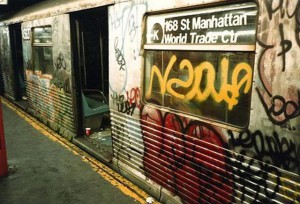 Style Wars depicted not only famous graffiti artists such as Skeme, Dondi, MinOne, and ZEPHYR, but also reinforced graffiti’s role within New York’s emerging hip-hop culture by incorporating famous early break-dancing groups such as Rock Steady Crew into the film and featuring rap in the soundtrack. Style Wars is still recognized as the most prolific film representation of what was going on within the young hip hop culture of the early 1980s. Fab 5 Freddy and Futura 2000 took hip hop graffiti to Paris and London as part of the New York City Rap Tour in 1983. Hollywood also paid attention, consulting writers such as PHASE 2 as it depicted the culture and gave it international exposure in movies such as Beat Street.
Style Wars depicted not only famous graffiti artists such as Skeme, Dondi, MinOne, and ZEPHYR, but also reinforced graffiti’s role within New York’s emerging hip-hop culture by incorporating famous early break-dancing groups such as Rock Steady Crew into the film and featuring rap in the soundtrack. Style Wars is still recognized as the most prolific film representation of what was going on within the young hip hop culture of the early 1980s. Fab 5 Freddy and Futura 2000 took hip hop graffiti to Paris and London as part of the New York City Rap Tour in 1983. Hollywood also paid attention, consulting writers such as PHASE 2 as it depicted the culture and gave it international exposure in movies such as Beat Street.
This period also saw the emergence of the new stencil graffiti genre. Some of the first examples were created in 1981 by graffiti artist Blek le Rat in Paris; by 1985 stencils had appeared in other cities including New York City, Sydney, and Melbourne.
GRAFFITI
Graffiti are writings or drawings that have been scribbled, scratched, or sprayed illicitly on a wall or other surface, often in a public spaces. Graffiti ranges from simple written words to elaborate wall paintings, and it has existed since ancient times, with examples dating back to Ancient Egypt, Ancient Greece, and the Roman Empire.
In modern times, paint (spray paint) and marker pens have become the most commonly used graffiti materials. In most countries, marking or painting property without the property owner’s consent is considered defacement and vandalism, which is a punishable crime.
Graffiti may also express underlying social and political messages and a whole genre of artistic expression is based upon spray paint graffiti styles. Within hip hop culture, graffiti has evolved alongside hip hop music, b-dancing, and other elements. Gangs use their own form of graffiti to mark territory or to serve as an indicator of gang-related activities.
Controversies that surround graffiti continue to create disagreement amongst city officials, law enforcement, and writers who wish to display and appreciate work in public locations. There are many different types and styles of graffiti and it is a rapidly developing art form whose value is highly contested and reviled by many authorities while also subject to protection, sometimes within the same jurisdiction.
Kobra’s “Kiss”
Graffiti Painting made by Brazilian artist Eduardo Cobra. The artist have a passion for vintage images. His aim is to preserve the historical aspect and to evoke a certain cultural memory which evokes certain emotions, he says. This painting is located in Chelsea (Manhattan), a short walk to where the original photo was taken decades ago by Alfred Eisenstaedt, whom titled it VJ Day in Times Square.
Through the image we can perceive the combination of old and new; the mix of a vintage iconic photo and the vivid colored-hip hop feel Kobra adds to it, characteristic of his work.
I took this picture with my iPhone while taking a walk along the High Line Park. This painting is so vivid, live, color-powered that complements perfectly (or competes) with the already astonishing view of the city’s skyline this park offers.
Street Art and Hip Hop – Forever Connected
Graffiti/street art is one of the original pillars of hip hop culture which dates back to the 70s. Street art and hip hop is driven by a DIY attitude along with intesive levels of creativity. What separates a “good” artist from a legendary or revolutionary one is often a matter of how far are they willing to push boundaries and perceived norms. While a large percentage of this generation has forgotten the roots of both hip hop and art, there are also many that thirst for knowledge and respect the culture.
Whether it was art or the hip hop, the 90s ushered in a new generation of creative geniuses. From college graduates to college dropouts to former pimps and drug dealers, many realized that these areas of interest could become a source of serious income. This in conjunction with the rebellious nature of the 90s lead to new musical and artistic genres being established. Regional sounds began to rise and were the representation of cultures being developed over several decades.
This was only a guest post so if you are interested in more 90s Hip Hop please check out my blog for more indepth culture and analysis. https://openlab.citytech.cuny.edu/90sforevahandevah/
My Day Job Versus My Passion
If you are an independent person trying to make a decent living, paying your bills on time to build up a good credit, and going through school without sinking your self in a thousands of dollars debt, you have most likely come across this very common dilemma.
There is a time for all of us when we have to make crucial decisions about our life and prioritize it, but how to do it without sabotaging ourselves. Sometimes what we think is right, is really not. And then there are some many factors to take in consideration when choosing and/or balancing between a day job and a passion. There is not an easy way out of this dilemma. Personally, I have been working full time jobs and basically being a full time student since I started school. Working full time allows me to pay for my bills, put a roof over my head, and afford lifestyle. And in order for me to obtain some financial aid from government I have no other choice but to go to school full-time (which does not really bothers me) if I want to walk out of it without thousand of dollars in debt.
Every person and case is different so if you are having a hard time trying to figure out what is more important or how to balance your job and your passion, you will not find a straight answer here, this is just me sharing my experiences. You might as well just focus on school and forget about getting a job if you get financial aid from either your parents or government, and/or you do not mind getting in debt. Or maybe you are one lucky person who loves your job. I chose to balance my day job in the hospitality industry (restaurant) and my passion, art; because i like enjoying life, while working in a career in that will allow me to have a decent living in the near future.
Now if you are like me and you do not mind work your ass off in a day job while going to school and still be able to go to a cool spot to hang out with friend or be able to take for dinner that hot chick in your class, here are some tips (based on my experience):
Work smart AND hard
Forget the average $8-10/h job. Find a job where you can make some decent money and flexible enough so can manage going to school. I would recommend to look for something where you can earn some tips. The more exclusive and expensive the place, the better the tips. Remember you can learn anything so if you think you do not have the skills then train your self.
Plan your schedule
Plan an efficient schedule that accommodates to your needs. Over the time i found more efficient to divide my schedule in school days and work days. Meaning i would go to school 2-3 days/week all day (or do homework), and then go to work 3-4 days/week all day. I am not a big fan of mix days where you go to work in the morning and go to school at night, i used to do it and i was always too tired to pay attention.
Get your ass up!
You want to have a good living, a successful career, and a hot girlfriend, then get your ass up and get to work!
Topic selected from
http://www.chrisbrogan.com/100-blog-topics-i-hope-you-write/
Mission Statement
This is the mission statement
Hello world!
Welcome to CityTech OpenLab. This is your first post. Edit or delete it, then start blogging!

